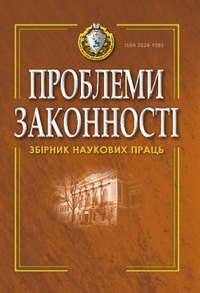Central Council and zemstvo self-government: march–october 1917
DOI:
https://doi.org/10.21564/2414-990x.136.91625Keywords:
Central Council, General Secretariat, zemstvo self-government, zemstvo elections, democratic reform, ukrainizationAbstract
As a social and political association, the Central Council emerged on March 3, 1917 as a result of the February Revolution in Russia. At that time, under the conditions of the First World War, there was a decline in zemstvo economy, increase in an amount of unpaid zemstvo taxes, decrease in a volume of zemstvo income and concurrently increase in spendings. As a consequence, there was a financial failure of zemstvos. Taking this into consideration, they lost public trust and support. Therefore, one of the most important reforms of the Provisional
Government of Russia was to be a reform of zemstvo self-government that received a full support of the Central Council. According to the leaders of the Central Council, the reform would provide ukrainization, democratization and modernization of zemstvos, establishing such local authorities on their basis which the Central Council would rest upon in its regional policy. As a result of the reforms and establishing cooperation between the Central Council and zemstvos, they had to be transformed into genuine local authorities and form the foundation of the Ukrainian statehood.
In the spring of 1917, zemstvos expressed their support for the Central Council. They started ukrainization of their own institutions, conducted active social, political and educational activities which were aimed at supporting nation creative activities of the Central Council, spreading the ideas of the Ukrainian statehood and carrying out democratic reforms. Zemstvos promoted in the making of the social and political association «Prosvita» (Enlightenment). However, in July 1917, the Central Council started preparations for introduction of a new system of local self-government.
According to legislation of the Provisional Government of Russia, in September 1917, democratic elections for councilors of provincial, county and township zemstvos were held. As a consequence of the elections, the process of democratization and ukrainization of zemstvos took place. Not nobles but peasants constituted more than 60% of zemstvo composition. The newly elected zemstvos fully supported the policy of the Central Council. However, the distancing process between the Central Council and zemstvos continued to develop after the democratic elections to zemstvos. This contradictory attitude of the Central Council to zemstvo self-government was due to two main factors. On the one hand, zemstvos actively supported the national state creative process that prompted the Central Council to cooperate with them. However, during the First World War, there was a decline in zemstvo economy, zemstvos lost public trust and support. So, on the other hand, cooperation with zemstvo self-government discredited the Central Council.
References
Kopylenko, O.L. (1992). «Sto dniv» Centralnoj Rady. Kiev: «Ukraina» [in Ukrainian].
Reveguk, V. (2002). Poltavzhchina v dobu Ukrainskoj revolucij 1917–1920 rr. Poltava : ASMI [in Ukrainian].
Postanovlenja nadzvichajnih zemskih zboriv 11 bereznja ta 23–25 travnja 1917 r. (1917). Poltavske povitove zemstvo. Poltava: Druk [in Ukrainian].
Gvozdik, V.S. (2010). Zemstva Ukrainy v umovah revolucijnih potrysin 1917 roku. Naukovi praci istorichnogo fakultetu Zaporizkogo nacionalnogo universitetu. Issue ХХІХ, 95–105 [in Ukrainian].
Smolij, V.А., Verstuk, V.F. (Eds). (1996). Ukrainska Centralna Rada. Dokumenty i materialy: Vol. 1–2, Vol. 2. Kiev: Nauk. dumka [in Ukrainian].
Smolij, V.А., Verstuk, V.F. (Eds). (1996). Ukrainska Centralna Rada. Dokumenty i materialy: Vol. 1–2, Vol. 1. Kiev: Nauk. dumka [in Ukrainian].
Zhurnali pozachergovogo Poltavskogo gubernskogo zemskogo zibranja 22-23 chervnja 1917 r. (1917). Poltava: Druk. І.L. Frishberga [in Ukrainian].
Doklad № 3 Mirgorodskoj povitovoj zemskoj upravi pro vidanja zemskoj gazeti «Prosvita». Derzhavnij arhiv Poltavskoj oblasti (dаlі – DАPО), f. 610, оp. 1, spr. 3, аrk. 4-4 zv. [in Ukrainian].
Doklad № 16 Mirgorodskoj povitovoj zemskoj upravi pro dijalnist Buro Prosviti vid 20.08.1917 r. – DАPО), f. 610, оp. 1, spr. 3, аrk. 21-22 zv. [in Ukrainian].
Zogal, S. (2008). Zemski vibori na Poltavszczini (serpen-veresen 1917 r.). Poltavskij krajznavchij musej. Malovidomi storinki istorij, muzeeznavstva, ohorona pamjatok : zb. Nauk. Statej. Volochin, U.V., Godzenko, V.D. (Eds). Issue ІV. Кn. 1. Poltava [in Ukrainian].
Poltavski povitovi zemski zbori (1917). Hutorjanin. 29–30, 590–597 [in Ukrainian].
Uezdnoe zemskoe sobranie (1917). Poltavskij den. 17 оkt. [in Ukrainian].
Downloads
Published
How to Cite
Issue
Section
License
Copyright (c) 2017 Анатолий Іванович Козаченко

This work is licensed under a Creative Commons Attribution 4.0 International License.










